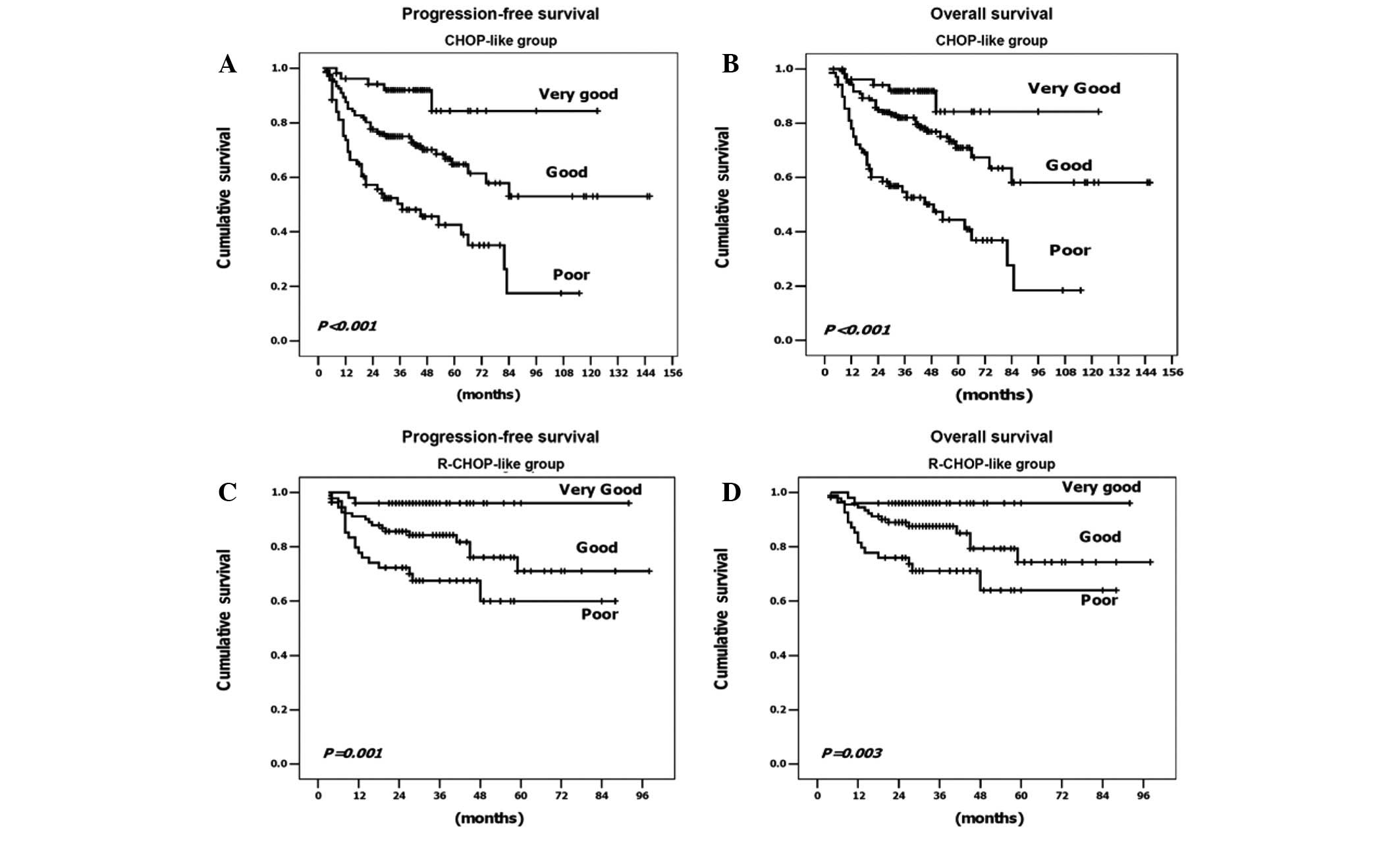|
1.
|
Gross SA, Zhu X, Bao L, et al: A
prospective study of 728 cases of non-Hodgkin lymphoma from a
single laboratory in Shanghai, China. Int J Hematol. 88:165–173.
2008. View Article : Google Scholar : PubMed/NCBI
|
|
2.
|
Wang J, Young L, Win W and Taylor CR:
Distribution and ZAP-70 expression of WHO lymphoma categories in
Shanxi, China: a review of 447 cases using a tissue microarray
technique. Appl Immunohistochem Mol Morphol. 13:323–332. 2005.
View Article : Google Scholar : PubMed/NCBI
|
|
3.
|
Lossos IS: Molecular pathogenesis of
diffuse large B-cell lymphoma. J Clin Oncol. 23:6351–6357. 2005.
View Article : Google Scholar : PubMed/NCBI
|
|
4.
|
Gordon LI, Harrington D, Andersen J, et
al: Comparison of a second-generation combination chemotherapeutic
regimen (m-BACOD) with a standard regimen (CHOP) for advanced
diffuse non-Hodgkin’s lymphoma. N Engl J Med. 327:1342–1349.
1992.PubMed/NCBI
|
|
5.
|
Fisher RI, Gaynor ER, Dahlberg S, et al:
Comparison of a standard regimen (CHOP) with three intensive
chemotherapy regimens for advanced non-Hodgkin’s lymphoma. N Engl J
Med. 328:1002–1006. 1993.PubMed/NCBI
|
|
6.
|
Feugier P, Van Hoof A, Sebban C, et al:
Long-term results of the R-CHOP study in the treatment of elderly
patients with diffuse large B-cell lymphoma: a study by the Groupe
d’Etude des Lymphomes de l’Adulte. J Clin Oncol. 23:4117–4126.
2005.PubMed/NCBI
|
|
7.
|
Pfreundschuh M, Trümper L, Osterborg A, et
al: CHOP-like chemotherapy plus rituximab versus CHOP-like
chemotherapy alone in young patients with good-prognosis diffuse
large-B-cell lymphoma: a randomised controlled trial by the
MabThera International Trial (MInT) Group. Lancet Oncol. 7:379–391.
2006. View Article : Google Scholar
|
|
8.
|
The International Non-Hodgkin’s Lymphoma
Prognostic Factors Project: A predictive model for aggressive
non-Hodgkin’s lymphoma. N Engl J Med. 329:987–994. 1993.
|
|
9.
|
Shipp MA: Prognostic factors in aggressive
non-Hodgkin’s lymphoma: who has ‘high-risk’ disease? Blood.
83:1165–1173. 1994.
|
|
10.
|
Sehn LH, Berry B, Chhanabhai M, et al: The
revised International Prognostic Index (R-IPI) is a better
predictor of outcome than the standard IPI for patients with
diffuse large B-cell lymphoma treated with R-CHOP. Blood.
109:1857–1861. 2007. View Article : Google Scholar : PubMed/NCBI
|
|
11.
|
Cheson BD, Horning SJ, Coiffier B, et al:
Report of an international workshop to standardize response
criteria for non-Hodgkin’s lymphomas. NCI Sponsored International
Working Group. J Clin Oncol. 17:12441999.PubMed/NCBI
|
|
12.
|
Broyde A, Boycov O, Strenov Y, Okon E,
Shpilberg O and Bairey O: Role and prognostic significance of the
Ki-67 index in non-Hodgkin’s lymphoma. Am J Hematol. 84:338–343.
2009.
|
|
13.
|
Lossos IS and Morgensztern D: Prognostic
biomarkers in diffuse large B-cell lymphoma. J Clin Oncol.
24:995–1007. 2006. View Article : Google Scholar : PubMed/NCBI
|
|
14.
|
Nyman H, Jerkeman M, Karjalainen-Lindsberg
ML, Banham H, Enblad G and Leppä S: Bcl-2 but not FOXP1, is an
adverse risk factor in immunochemotherapy-treated non-germinal
center diffuse large B-cell lymphomas. Eur J Haematol. 82:364–372.
2009. View Article : Google Scholar : PubMed/NCBI
|
|
15.
|
Alacacioglu I, Ozcan MA, Ozkal S, et al:
Prognostic significance of immunohistochemical classification of
diffuse large B-cell lymphoma. Hematology. 14:84–89. 2009.
View Article : Google Scholar : PubMed/NCBI
|
|
16.
|
Ennishi D, Takeuchi K, Yokoyama M, et al:
CD5 expression is potentially predictive of poor outcome among
biomarkers in patients with diffuse large B-cell lymphoma receiving
rituximab plus CHOP therapy. Ann Oncol. 19:1921–1926. 2008.
View Article : Google Scholar : PubMed/NCBI
|
|
17.
|
Bari A, Marcheselli L, Sacchi S, et al:
Prognostic models for diffuse large B-cell lymphoma in the
rituximab era: a never-ending story. Ann Oncol. 21:1486–1491. 2010.
View Article : Google Scholar : PubMed/NCBI
|
|
18.
|
Vitolo U, Chiappella A, Angelucci E, et
al: Dose-dense and high-dose chemotherapy plus rituximab with
autologous stem cell transplantation for primary treatment of
diffuse large B-cell lymphoma with a poor prognosis: a phase II
multicenter study. Haematologica. 94:1250–1258. 2009. View Article : Google Scholar : PubMed/NCBI
|
|
19.
|
Ziepert M, Hasenclever D, Kuhnt E, et al:
Standard International prognostic index remains a valid predictor
of outcome for patients with aggressive CD20+ B-cell
lymphoma in the rituximab era. J Clin Oncol. 28:2373–2380. 2010.
View Article : Google Scholar : PubMed/NCBI
|
|
20.
|
Pfreundschuh M, Schubert J, Ziepert M, et
al: Six versus eight cycles of bi-weekly CHOP-14 with or without
rituximab in elderly patients with aggressive CD20+
B-cell lymphomas: a randomised controlled trial (RICOVER-60).
Lancet Oncol. 9:105–116. 2008. View Article : Google Scholar : PubMed/NCBI
|
|
21.
|
Glass B, Kloess M, Bentz M, et al:
Dose-escalated CHOP plus etoposide (MegaCHOEP) followed by repeated
stem cell transplantation for primary treatment of aggressive
high-risk non-Hodgkin lymphoma. Blood. 107:3058–3064. 2006.
View Article : Google Scholar : PubMed/NCBI
|
|
22.
|
Tay K, Tai D, Tao M, Quek R, Ha TC and Lim
ST: Relevance of the International Prognostic Index in the
rituximab era. J Clin Oncol. 29:e142011. View Article : Google Scholar : PubMed/NCBI
|
|
23.
|
Advani RH, Chen H, Habermann TM, et al:
Comparison of conventional prognostic indices in patients older
than 60 years with diffuse large B-cell lymphoma treated with
R-CHOP in the US Intergroup Study (ECOG 4494, CALGB 9793):
consideration of age greater than 70 years in an elderly prognostic
index (E-IPI). Br J Haematol. 151:143–151. 2010.
|
















